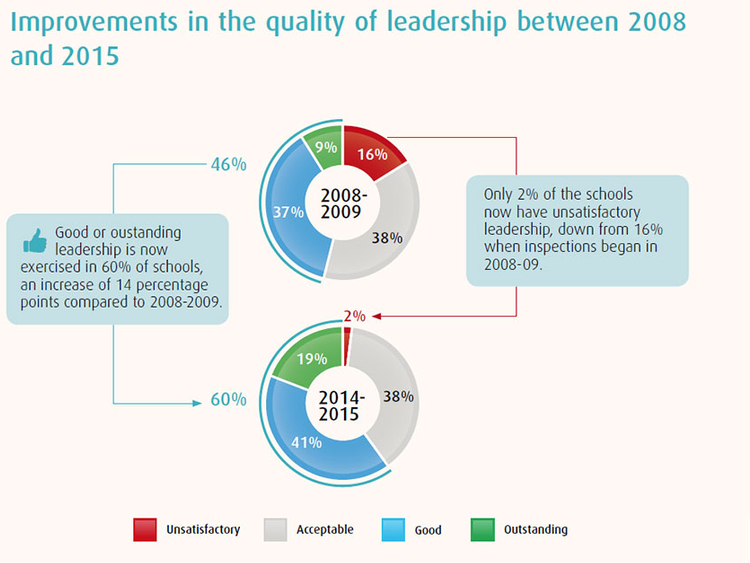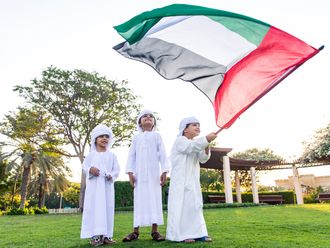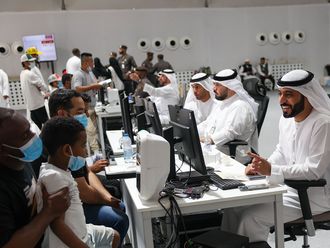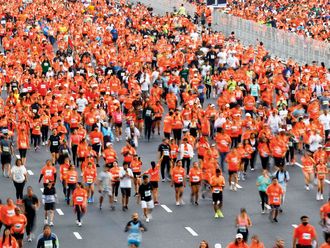
Dubai: Looking back on seven years of school inspections, private schools in Dubai have shown significant improvement in performance.
However, Arabic taught in these schools remains a great concern.
The 2014-15 annual Knowledge and Human Development Authority (KHDA) inspection report, which was to be released on Tuesday, shows how far the private education sector of Dubai has improved since the first inspection in 2008.
The report found that 52 schools (36 per cent) of the schools inspected this year have improved their overall rating since their first year of inspection, while 15 (10 per cent) of the schools inspected this year have declined in their overall rating.
The percentage of students attending schools that were judged good or outstanding overall has increased from about 30 per cent of the total number of students in the schools inspected in 2008-2009 to almost 53 per cent in 2014-2015.
The increase in ranking can be attributed to the increase in the number of private schools as they have grown from 143 during the 2008-09 academic year to 169 in the 2014-15 academic year, an increase of 18 per cent.
Over the same period of time, the number of students attending Dubai’s private schools increased by 44 per cent from 177,587 to 255,208.
Jameela Al Muhairi, Chief of DSIB, said development in performance can be seen across all areas of education, thanks to huge efforts from schools, parents, teachers and other stakeholders to improve the quality of education.
“Our recommendations are designed to help schools continue this journey of improvement and to carry on working to provide accessible, high quality private education in Dubai,” said Jameela.
The number of students attending schools that were judged unsatisfactory has decreased from about 14 per cent of the total number of students in the schools inspected in 2008-2009 to almost 5 per cent in 2014-2015.
Over the past seven years, nine schools closed after they were rated as unsatisfactory in their final school inspection.
School inspection results for 2014-15
The 2014-15 report revealed that nine schools have improved their overall rating while four other schools dropped in their overall performance.
KHDA inspected 143 schools (255,208 students) during 2014/15. Of these, 14 were rated ‘Outstanding’, 59 were rated ‘Good’, 61 were ‘Acceptable’ and 9 were considered ‘Unsatisfactory’.
Receiving a high inspection ranking from the KHDA during annual inspection is important for the school’s sustainability because the fee framework is dependent on these rankings. The higher the school ranks, the more it can increase its fees.
The number of schools rated ‘Outstanding’ in the annual school inspections conducted by the KHDA’s Dubai School Inspection Bureau (DSIB) finally increased after remaining static for the last two years.
Two schools, Repton School and the French Lycée International Georges Pompidou Primary School, Oud Metha, improved their rating from ‘good’ to ‘outstanding’, for the first time in six years.
Saadia Hachid, Principal of French Lycée Georges Pompidou Primary School’s kindergarten section, said her school was able to achieve this rating through offering a curriculum that meets the children’s needs, teaching for effective learning, having a safe and outstanding environment and assessing the children’s learning skills.
On the other hand, six schools improved their rating from ‘acceptable to good. They include Al Mawakeb School Al Garhoud, The Westminster School, Mirdif Private School, Iranian Towheed Boys School Collegiate American School and JSS Private School.
Chitra Sharma, Principal of JSS Private School, said her school was able to improve its rating through strong and positive relationships among leaders, staff, students and parent community, which helped them introduce and sustain school improvement plans.
“The improvement plans included reviewing of the school’s curriculum, benchmarking it to international standards and introducing internationally comparable achievement tests which were instrumental in getting desirable results,” she said.
The New Academy School also improved its ranking this year from ‘unsatisfactory’ to ‘acceptable’.
Meanwhile, four other schools dropped in their overall rating this year.
Schools that dropped from ‘good’ to ‘acceptable’ include GEMS Our Own Indian School and Dubai International Private School.
Schools that dropped in rating from ‘acceptable’ to ‘unsatisfactory’ include Al Sadiq Islamic English School and Islamic School for Training and Education.
The KHDA report found that schools which follow the British curriculum are the highest performing schools as most of the schools rated outstanding (10 of the 14) are ones that follow the British curriculum.
Areas of Weakness among American schools
American schools, on the other hand, are not doing as well as British schools because 21 out of the 31 American schools were only rated ‘acceptable’.
The KHDA identifies ‘assessment’ as one of the weaknesses of American schools, as only 31 per cent of schools that follow the American curriculum were judged as having ‘good’ or better assessment.
The KHDA report also found that the one other concern regarding assessment in US curriculum schools is the lack of recognition of high school diplomas.
Only about one third of Dubai’s US curriculum schools currently provide their graduating students with diplomas that are recognised in the United States.













